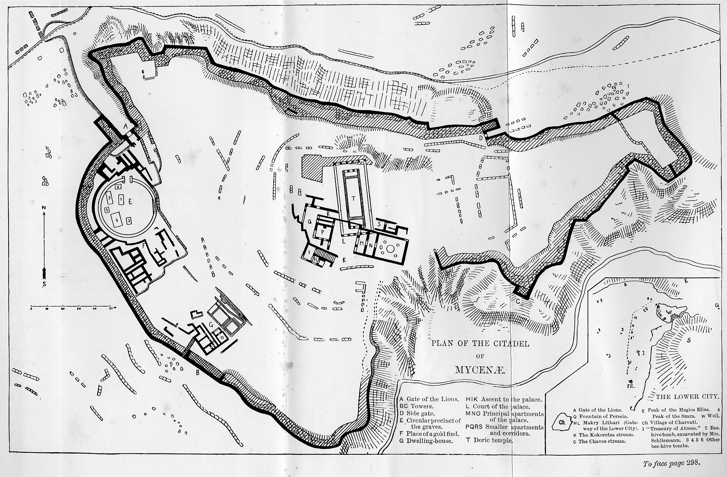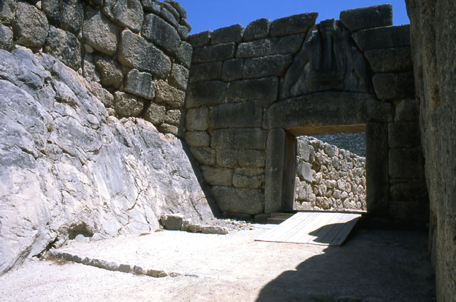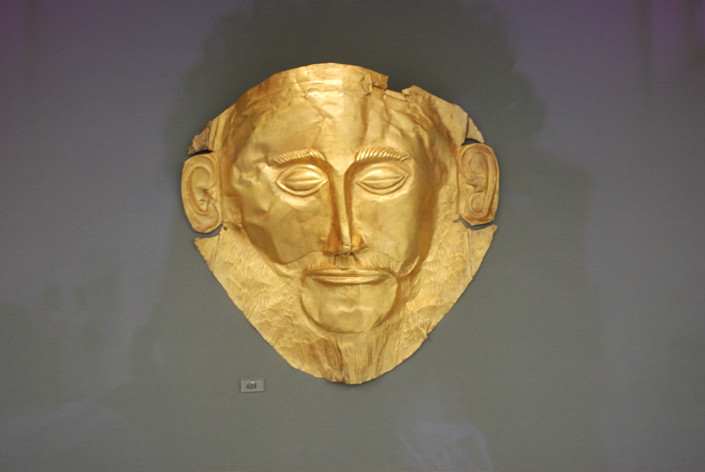Mycenae
Mycenae is the location of one of the important Bronze Age (Late Helladic) sites in Greece, a principal site of the Mycenaean culture, located in the Argolid. In mythological terms, the founding of Mycenae is attributed to the hero Perseus. Mycenae as we know it today, with famous late Bronze Age remains preserved for observation and study, began with the excavation of the site by Heinrich Schliemann as part of his series of large-scale digs at Bronze Age sites throughout the late 19th century. Discussions of Mycenae and Mycenaean civilization are inextricably linked to the Homeric epics. This is partly due to the fact that Schleimann’s excavation techniques, which left the remains of subsequent periods all but lost.
Evidence of historical activity on the site, even on a very complex level, goes back well before the building of the citadel, as evidenced by the finds at Grave Circle A (from the period after 1675). However, archeologists have dated the height of Mycenaean culture, and Bronze Age activity at Mycenae, from after the decline of Minoan civilization around 1400 to the mysterious destructions across the area at the beginning of the 12th century.

Stylistically, Mycenean construction owes much to Minoan architectural traditions as exemplified by Knossos. However, the Mycenaean citadels overall are vastly different from the palaces of their Cretan neighbors. Their design offers many important innovations, particularly with regard to large fortification walls, well preserved both at Mycenae itself and at Tiryns. The walls of Mycenae are constructed both of large ashlar masonry (shaped stone blocks) and cyclopean masonry (huge unshaped limestone boulders), and are thought to have been constructed first in the 14th century and subsequently expanded to wall in important nearby areas. The Lion Gate, so called for the stone relief of rearing lions that fills the reliving triangle (an engineering innovation used to reduce the weight carried in a post-and-lintel opening) above the lintel block, is among the earliest examples of large-scale stone sculpture known. Scholars have also noted the military ingenuity involved in the wall design, such as short spur walls outside gates thought to have exploited the vulnerable left side of attacking soldiers. Another militarily useful architectural feature is a subterranean passageway used to access a spring just outside the city walls, which employs corbelled vaulting to maintain strength.

The palace building itself, though not well preserved, shows many of the characteristics of the architecture of Mycenean royal dwellings, especially the clear presence of a megaron. This establishes a clear connection to better preserved examples of similar structures, such as at Pylos.
Many significant finds have come from the site of Mycenae. It has been a major source for tablets in Linear B, the written form of the early Greek language. Numerous ceramic forms have been unearthed, along with terra cotta and ivory figurines, and examples of sophisticated metal work. Within the walls, Grave Circle A has produced impressive grave goods from its several burial shafts, including grave stele, gold funerary masks and daggers with silver and gold inlay. Nearby, Mycenean tholos tombs such as the Treasury of Atrues offer good examples of the extent of Bronze age engineering skill.

Mycenae as a site was used in other contexts for many years, even after the decline of the Mycenaean culture. Part of the megaron was cleared away, for example, in the construction of a temple in Hellenistic times. These Hellenistic remains themselves were removed to access the past represented by the Bronze Age materials. Even with the loss of most of the relevant remains form subsequent periods, the value of the site is widely recognized, and was designated a UNESCO World Heritage Site in 1999.
Biers, William R. The Archaeology of Greece. Ithaca: Cornell University Press, 1980.
"Mycenae." Encyclopædia Britannica. 2007. Encyclopædia Britannica Online. 10 Dec. 2007 <http://www.britannica.com/eb/article-9054521>.
Posted at Dec 16/2007 10:25PM:
Kuy Yeon Lee: Thanks again form reminding me of Mycenae. It's such an important heritage in Ancient Greek civilization, but since we've gone through it too long time ago... this has been a very brief but clear review. Good job!!
